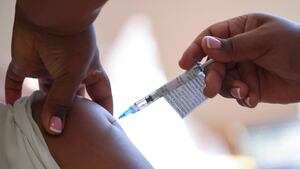It’s not exactly breaking news that the novel coronavirus is evolving. Dangerous new variants—also called mutations, or “lineages”—have been cropping up all over the world since last fall, complicating efforts to end the pandemic.
The big question is, what will the virus do next? To some scientists, the fact that many of the new lineages feature identical mutations—despite appearing separately in different parts of the world—means the SARS-CoV-2 pathogen is running out of ways to evolve. But another school of thought suggests the coronavirus has plenty of tricks left up its genetic sleeve.
Welcome to Rabbit Hole, where we dive deep on the biggest story. It’s for Beast Inside members only. Join up today.
It would certainly be reassuring, as vaccines finally roll out and case numbers plateau, if this once-in-a-lifetime pathogen were losing its edge, so to speak.
“The fact that different variants have independently hit on the same mutations suggests we’re already seeing the limits of where the virus can go,” Jason McLellan, a structural biologist at the University of Texas at Austin, recently told The New Yorker. “It has a finite number of options.”
But plenty of scientists reject the idea that the novel coronavirus is at an evolutionary dead end. The virus could still surprise us, they insist, and we are not even close to having this thing figured out.
“We're not in a position to forecast that evolutionary changes are indicative of the virus being ‘trapped,’ ‘cornered,’ or otherwise weakened,” Anna Fagre, a Colorado State microbiologist, told The Daily Beast. “I worry that leaning too strongly into this stance will result in premature relaxation.”
For most of last year, SARS-CoV-2 mutated without actually producing significant new lineages. That began to change around September with the emergence of the B.1.1.7 variant in the United Kingdom and, a few weeks later, the first appearance of B.1.351 in South Africa. Several weeks after that, the P.1 lineage was detected for the first time, in Brazil.
All three of those variants have since spread across the United States. Meanwhile, both New York and California have produced their own unique lineages—B.1.526 and B.1.427/B.1429, respectively.
There’s some evidence that all the new lineages are either more transmissible than the baseline SARS-CoV-2 or partially resist the immunity-inducing effects of the various COVID-19 vaccines less—or both. And in the case of the U.K. variant, there’s evidence it is more deadly, too.
Depending on your vantage point, the genetic makeup of the new lineages might be cause for cautious optimism. All of the variants feature one or both of a pair of key mutations called N501Y and E484K. That separate-but-simultaneous mutation is something geneticists call “convergent evolution.”
N501Y affects the spike protein that’s a distinctive feature of the novel coronavirus. The spike protein helps the virus grab onto our cells’ receptors. It seems N501Y makes the spike protein “grabbier” and more likely to cause infection.
E484K, on the other hand, could reduce the effectiveness of vaccines.
The mutations are scary, optimists concede. But their convergent evolution suggests the various lineages had no other genetic options, according to McLellan. “This is what we think happened to viruses that cause the common cold,” McLellan told The New Yorker. “It probably caused a major illness in the past. Then it evolved to a place where it’s less deadly.”
In essence, the cold-causing adenovirus simply got old—and lost potency. Convergent evolution could do the same thing to SARS-CoV-2, he posited: “There’s just not a lot of space for the spike [protein] to continue to change in ways that allow it to evade antibodies but still bind to its receptor.”
McLellan didn’t respond to a request for comment for this story. But Niema Moshiri, a geneticist at the University of California, San Diego, endorsed his theory—with a grim twist. The novel coronavirus is close to becoming the worst possible version of itself, but only because we let it, Moshiri told The Daily Beast.
“From my perspective, given that we've already given COVID-19 the ability to essentially have a free-for-all mutation-spree by letting it spread so far, the fact that relatively few positions in the spike protein have variability suggests to me that there probably aren't too many other places in the spike protein for a new super-impactful mutation to come about,” Moshiri said.
But most of the experts The Daily Beast canvassed disagreed that this thing is near the end of its genetic rope.
“I haven’t seen any indication that SARS-CoV-2 is running out of evolutionary space,” Jesse Bloom, an investigator at the Fred Hutchinson Cancer Research Center in Washington state, told The Daily Beast. “Based on analyses of other antigenically-evolving respiratory viruses such as influenza virus and CoV-229E, I expect SARS-CoV-2 will continue to evolve over the coming years.”
Equally troubling, it could evolve into dangerous new lineages without us noticing—until those lineages have infected a lot of people and, in the worst case, jumpstarted a whole new phase of the pandemic.
Health authorities are doing too little testing, as everyone on both sides of this debate concedes. And that means labs don’t have all the raw coronavirus samples they need to scan for genetic trends and alert us to new lineages. “We are not doing nearly enough genetic surveillance to understand these problems,” Rob Knight, the head of a genetic-computation lab at the University of California, San Diego, told The Daily Beast.
Even if we get lucky and SARS-CoV-2 does weaken with age, we can’t relax, Stephanie James, the head of a COVID testing lab at Regis University in Colorado, told The Daily Beast.
That’s because the novel coronavirus isn’t the only coronavirus. There are a lot of similar viruses in animal populations. As may have happened with SARS-CoV-2, exposing the wrong people to the wrong bat or pangolin or ferret could cause a global catastrophe—and fast. “As humans continue to encroach on areas of Earth that have not been inhabited by humans, we can expect this trend to continue,” James said.
While scientists might disagree on the novel coronavirus’ evolutionary future, they’re unanimous on matters of public health. Even if SARS-CoV-2 is genetically doomed, it’s still infecting 64,000 Americans a day, on average, right now. That means the same rules apply: Wear a mask. Avoid crowds. Get vaccinated when you can.
And keep getting tested. In fact, get tested more often, as testing numbers have come crashing down in recent weeks. It’s the tests that give scientists—both the optimists and pessimists—the samples they need to keep tabs on the virus’ changes, Fagre pointed out.
“Drastically increasing our sequencing efforts will provide us insights into how the virus is evolving at much higher resolution than we currently have,” she said, “and is necessary to proactively disrupt additional surges in case numbers as novel variants of concern emerge.”







